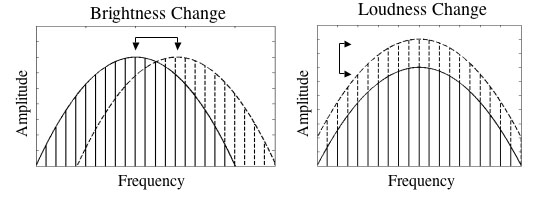
This page contains example stimuli from a paper that appeared recently in Psychological Science.
Our peception of pitch-varying stimuli is
dominated by relative pitch - the relationships between the pitch of
successive sounds. Relative pitch enables us to recognize melodies when
they are transposed up or down in pitch, or to hear the same utterance
by different speakers as having the same intonation pattern. Although
there are thousands of studies of absolute pitch (i.e. the pitch of
isolated notes), very little is known about the mechanisms of relative
pitch. As a first step, we wondered whether properties of relative
pitch would generalize to other auditory dimensions.
We focused specifically on sound contours. The pitch contour of a
series of sounds is defined as the sequence of directions of pitch
changes from note to note (see part a of the figure, below). It is the
main determinant of melody recognition for novel random pitch
sequences. We tested whether contours could be perceived in dimensions
other than pitch.

Normally contours are thought to be the result of pitch changes, i.e. a change in fundamental frequency:

But in principle contours and intervals could be created from other dimensions as well. We studied two other salient auditory dimensions, brightness and loudness. Brightness is the perceptual correlate of the centroid of the spectrum of a sound, and is one of the most important aspects of timbre. Loudness is usually correlated with amplitude.

To study this experimentally we adapted the classic paradigm of Dowling and colleagues. Subjects were presented with two 5-note sequences that varied along a dimension, and had to say whether the two sequences followed the same pattern or not:

Here are example stimuli. Each file contains what you would hear in a
single trial of the experiment.
This is the vanilla case where both sequences vary in pitch. The second
one is transposed to a different pitch range, so that recognition
depends on relative pitch perception. In one case the second stimulus
contains the same contour, in the other it is different.
| Listen: | Or download the audio file. | |
| Listen: | Or download the audio file. |
It turns out that people are quite good at recognizing contours in other dimensions as well. Here are stimuli where the first and second stimuli vary in loudness. The second one is "transposed" to a higher range of loudness, so that again absolute levels of the "notes" are uninformative. Again, in one case the second stimulus contains the same contour, in the other it is different.
| Listen: | Or download the audio file. | |
| Listen: | Or download the audio file. |
| Listen: | Or download the audio file. | |
| Listen: | Or download the audio file. |
People are also pretty good at recognizing a contour from one dimension when it is replicated in another dimension.
Click here for demos of this.
Contours in dimensions other than pitch can also support the recognition of familiar melodies.
Click here for demos of this.